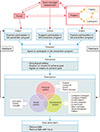3. Hayes N. Prevention of falls among older patients in the hospital environment. British Journal of Nursing. 2004; 13(15):896–901. DOI:
10.12968/bjon.2004.13.15.15525.


4. Park MH, Song KY. Risk factors of stroke patients falling in geriatric hospital. Journal of Korean Gerontological Nursing. 2005; 7(1):104–113.
5. Lee AS, Yoon CK. A study on nurses' perception to the patient safety in hospital. Korean Public Health Research. 2010; 36(2):73–82.
6. Bae J, Cho SI. Effects of community-based comprehensive fall prevention program on muscle strength, postural balance and fall efficacy in elderly people. Journal of Korean Academy of Nursing. 2014; 44(6):697–707. DOI:
10.4040/jkan.2014.44.6.697.


7. Rubenstein LZ, Josephson KR. Falls and their prevention in elderly people: What does the evidence show? Medical Clinics of North America. 2006; 90(5):807–824. DOI:
10.1016/j.mcna.2006.05.013.

8. Kim YL, Jeong SH. Effects of nursing interventions for fall prevention in hospitalized patients: A meta-analysis. Journal of Korean Academy of Nursing. 2015; 45(4):469–482. DOI:
10.4040/jkan.2015.45.4.469.


9. Vaapio S, Salminen M, Vahlberg T, Sjösten N, Isoaho R, Aarnio P, et al. Effects of risk-based multifactorial fall prevention on health-related quality of life among the community-dwelling aged: A randomized controlled trial. Health and Quality of Life Outcomes. 2007; 5:20. DOI:
10.1186/1477-7525-5-20.



11. Koh SS, Manias E, Hutchinson AM, Donath S, Johnston L. Nurses' perceived barriers to the implementation of a fall prevention clinical practice guideline in Singapore hospitals. BMC Health Services Research. 2008; 8:105.

12. Jung JY, Yun SY. Elder care related knowledge, attitudes, nursing practice and awareness of elder abuse in geriatric hospital health personnels. Journal of Korean Gerontological Nursing. 2012; 14(3):233–241.
13. Hur JY, Kim HJ. Relationship of risk factors, knowledge and attitude to falls in elderly inpatients. Journal of Korean Gerontological Nursing. 2009; 11(1):38–50.
14. Haines TP, Hill AM, Hill KD, McPhail S, Oliver D, Brauer S, et al. Patient education to prevent falls among older hospital inpatients: A randomized controlled trial. Archives of Internal Medicine. 2011; 171(6):516–524. DOI:
10.1001/archinternmed.2010.444.

15. Dykes PC, Carroll DL, Hurley A, Lipsitz S, Benoit A, Chang F, et al. Fall prevention in acute care hospitals: A randomized trial. JAMA. 2010; 304(17):1912–1918. DOI:
10.1001/jama.2010.1567.


16. Kato M, Izumi K, Shirai S, Kondo K, Kanda M, Watanabe I, et al. Development of a fall prevention program for elderly Japanese people. Nursing & Health Sciences. 2008; 10(4):281–290. DOI:
10.1111/j.1442-2018.2008.00404.x.


17. Vassallo M, Vignaraja R, Sharma JC, Hallam H, Binns K, Briggs R, et al. The effect of changing practice on fall prevention in a rehabilitative hospital: The hospital injury prevention study. Journal of the American Geriatrics Society. 2004; 52(3):335–339. DOI:
10.1111/j.1532-5415.2004.52102.x.


18. Lim JO, Gu MO. Fall-related circumstances and fall risk factors among inpatients with dementia in long-term care hospital. Journal of Korean Gerontological Nursing. 2016; 18(2):72–83. DOI:
10.17079/jkgn.2016.18.2.72.

19. Kim SH, Seo JM. Geriatric hospital nurses' knowledge, attitude toward falls, and fall prevention activities. Journal of Korean Gerontological Nursing. 2017; 19(2):81–91. DOI:
10.17079/jkgn.2017.19.2.81.

20. Lee HO, Lee BH, Lee CH. Effect of strength exercise on patient fall prevention program: Focusing on the fall high risk group elderly patients. Journal of Health Informatics and Statistics. 2017; 42(4):338–345. DOI:
10.21032/jhis.2017.42.4.338.

21. Jung JY, Park YJ, Jung GH. Effects of long term care hospital care-givers' fall prevention self efficacy and fall prevention health belief on fall prevention awareness. The Journal of the Korea Contents Association. 2015; 15(2):333–343. DOI:
10.5392/JKCA.2015.15.02.333.

22. King IM. King's conceptual system, theory of goal attainment, and transaction process in the 21st century. Nursing Science Quarterly. 2007; 20(2):109–111. DOI:
10.1177/0894318407299846.


23. Jeong IJ, Kim SJ. Effects of group counseling program based on goal attainment theory for middle school students with emotional and behavioral problems. Journal of Korean Academy of Nursing. 2017; 47(2):199–210. DOI:
10.4040/jkan.2017.47.2.199.


24. Park M, Song R, Jeong JO. Effect of goal attainment theory based education program on cardiovascular risks, behavioral modification, and quality of life among patients with first episode of acute myocardial infarction: Randomized study. International Journal of Nursing Studies. 2017; 71:8–16. DOI:
10.1016/j.ijnurstu.2017.02.019.


25. Faul F, Erdfelder E, Buchner A, Lang AG. Statistical power analyses using G*Power 3.1: Tests for correlation and regression analyses. Behavior Research Methods. 2009; 41(4):1149–1160. DOI:
10.3758/BRM.41.4.1149.


26. Morse JM, Tylko SJ, Dixon HA. Characteristics of the fallprone patient. The Gerontologist. 1987; 27(4):516–522. DOI:
10.1093/geront/27.4.516.


30. Chai KJ. A literature review a program of intervention for prevention of falling in the patients with dementia. The Journal of Occupational Therapy for the Aged and Dementia. 2010; 4(2):27–34.





